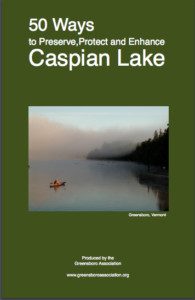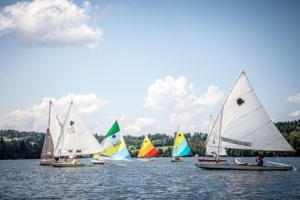Every house owner, renter and visitor to Caspian Lake has an opportunity to contribute to preserving and enhancing the lake’s unique natural beauty by committing to 50 Ways to Preserve, Protect, and Enhance Caspian Lake. Please take a look at the PDF document that outlines how we can protect our most valuable asset – Caspian Lake. And please thank Annie Paumgarten for her leadership and efforts in putting this book together and Cara Marquis, who provided the graphic design work for this booklet as a contribution…..her website:
Rules and Guidelines that Protect Our Lake and Community
Right of Way and Boat Handling:
- Approaching other boats: When two boats are approaching head-on, each shall bear to the right leaving the other boat on the left side. At an angle, the boat on the right has right-of-way. Powerboats should yieldthe right-of-way to all canoes, rowboats, sailboats and windsurfers.
- Managing boat wake: The wake from your boat must not endanger anyone else. Canoes and small boats are especially vulnerable to high-wake turbulence, and you are responsible for any act of yours which endangers or jeopardizes the safety, life or property of another person.
- Overloading: Do not exceed the recommended number of people your boat is built to carry safely, as shown on the plate mounted on the transom.
- Divers: Wholly submerged divers and snorklers must display a divers-down flag, which has a white diagonal stripe on a red background. No vessel, except a canoe or rowboat, may operate within 200 feet of a divers-down flag.
- Fisherman: Be considerate of people fishing. Steer well clear of their lines, whether they are trolling or still fishing. Fisherman over 14 must have a Vermont fishing license.
- Navigational Hazards: There are two submerged “islands” in the middle of Caspian Lake and many hidden rocks and shoals close to shores. Know their locations and avoid boat damage and personal injury by steering clear of these hazards.
Environmental Considerations:
- Wildlife: Loons, ducks and other birds are especially sensitive to boat traffic. It is a punishable offense to kill or harass any water bird through the operation of a boat on any Vermont lake.
- Littering: It is prohibited to throw refuse of any kind in the lake. Take all your trash away with you.
- Noise: Sound travels much farther over water than over land, especially in calm weather and at night. Many people come to Caspian Lake to enjoy its quiet beauty and peaceful fishing, which are particularly outstanding during the early morning and evening hours. We suggest that all users of the lake respect this tranquility by limiting noise and boat speeds before 8:00 in the morning and after one half hour before sunset.
- Sunday Concerts: During July and August, concerts are broadcasted every Sunday evening at the south end of the lake. It is requested that motorboats not operate in the area while concerts are in progress.
Aquatic Nuisance Species:
- Eurasian Watermilfoil: This prolific aquatic plant found in Lake Champlain and many inland lakes in Vermont interferes with boating, fishing and swimming, and displaces native plants. It is easily spread when plant fragments are caught and moved on boat trailers, propellers, anchors and other equipment, or in live wells.
- Zebra Mussel: These are tiny D shaped mollusks that are well established in Lake Champlain. They clog water intake pipes, damage boat engines, obscure historic shipwrecks, and alter native species populations. Adult zebra mussels can attach and be moved on boat hulls, engines and other equipment. Microscopic larva can get trapped and moved in water of boat engines, bilges, bait buckets, and live wells.
- Water Chestnuts: This prolific annual plant is found in southern Lake Champlain, Lake Bomoseen, and a few inland lakes. It interferes with boating, hunting and fishing, and displaces native plants. It is spread by seeds or rosettes caught on boats and equipment.
- Alewife: This small bait fish was recently found in Lake St. Catherine. It may displace our native forage fish and can be introduced to new waterbodies if it is accidentally caught and used for bait, or dumped from bait buckets or live wells.
Swimming Area:
- Entry Prohibited: All vessels, including windsurfers and canoes are prohibited from entering the designated swimming area at the public beach.
- This page presents only a summary of the Vermont boating safety operating laws and regulations applicable to Caspian Lake. A complete booklet, Vermont Boating Safety Operating Laws and Regulations, may be obtained free of charge from:
- The Vermont Department of Public SafetyState Police Marine Division103 South Main StreetWaterbury, VT 05671-2101.(802) 244-8727
- Accidents ( in case of death or if property damage exceeds $100 or if medical treatment beyond first aid is required) must be reported to the Vermont State Police in St. Johnsbury: 748-3111


